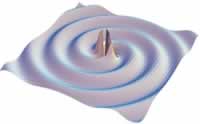"..... Help me Einstein!
Help, help me Einstein!
Spot the gravity wave."
A group of summer students working on the Laser Interferometric Gravitational-Wave Observatory, or LIGO, project at the California Institute of Technology created a medley of songs on YouTube to explain their research.
The handful of tunes, set to the music of popular classics including "The Time Warp", "Help Me, Rhonda," and "California Dreamin'", offer an alternative way to learn about the science. The lyrics are educational but the singing isn't exactly out of this world.
LIGO is operated by Caltech and MIT, and is a collaboration of more than 600 scientists working toward detecting and measuring cosmic gravitational waves. LIGO, which has installations in Hanford, Washington, and Livingston, Louisiana, is part of a planned worldwide network of gravitational wave observatories. Scientists believe these waves could carry clues to the nature of gravity.
A simulation of a gravitational wave. Courtesy of Caltech.
These waves are ripples in the fabric of space and time caused by energy called gravitational radiation getting pushed through the universe by a violent event such as a supernova explosion. The waves have only indirectly been detected.
LIGO began operation in 2001. If you would like to keep up on LIGO's progress, you can peruse the experiment's blog here.








